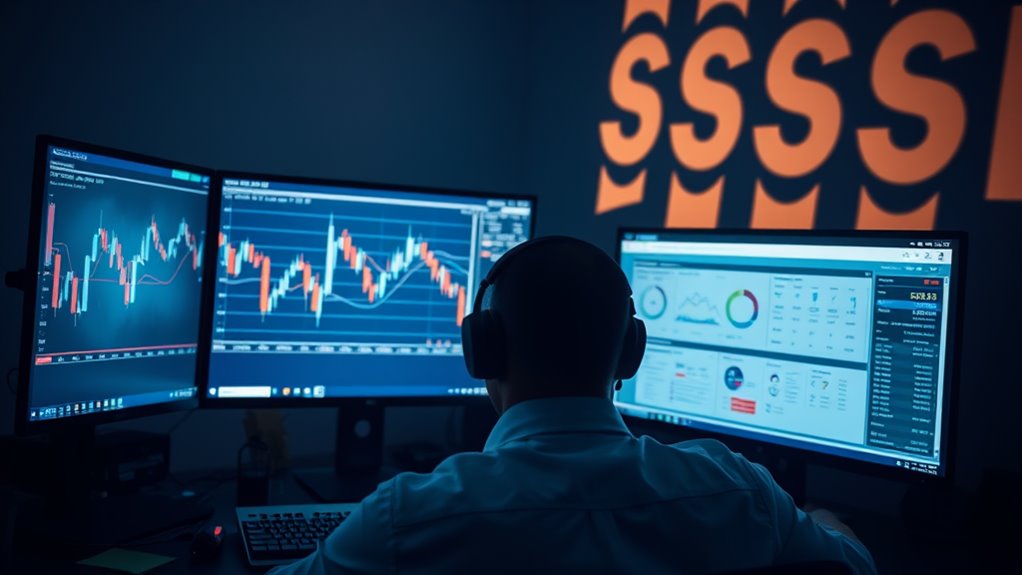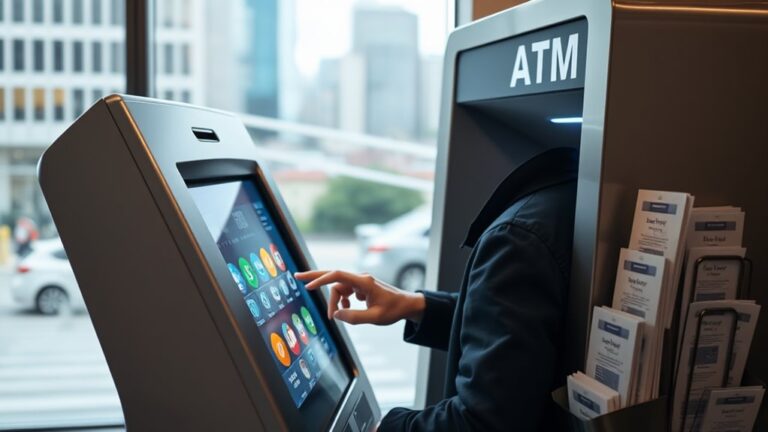
Breakout Trading: Protecting Gains Amid Volatile Markets
In volatile markets, breakout trading utilizes tools like Bollinger Bands and Average True Range to identify potential opportunities and manage risk effectively. Traders use volume spikes and technical indicators to anticipate and confirm breakouts, enhancing decision-making. By implementing stop-loss orders and correct position sizing strategies, traders protect gains and limit losses. Successfully adapting these techniques to current market conditions allows for capitalizing on volatility while maintaining financial stability. Discovering more about these strategies can provide further advantages.
Key Takeaways
- Implement stop-loss orders to automatically sell assets at a set price, minimizing losses during unexpected market downturns.
- Use technical indicators like Bollinger Bands and ATR to identify ideal exit points and manage trade exits effectively.
- Regularly adjust position sizing based on current market volatility and individual risk tolerance to safeguard investments.
- Engage in multi-timeframe analysis to gauge the robustness of a breakout, ensuring consistency across different time scales.
- Maintain emotional discipline by sticking to a predefined trading plan, reducing impulsive decisions in volatile market conditions.
Understanding the Role of Volatility in Breakout Trading

In the dynamic world of breakout trading, understanding volatility is vital. Volatility denotes the frequency and magnitude of financial instrument price changes. Highly volatile markets can experience swift and significant price shifts, offering traders opportunities for substantial gains.
Typically, volatility compresses before a breakout, only to expand rapidly afterwards, a phenomenon traders can exploit. Monitoring market conditions like economic announcements and geopolitical events is essential as these can profoundly alter volatility levels.
To accurately gauge these shifts, traders often utilize tools such as Bollinger Bands and Average True Range (ATR). These instruments assist in predicting potential breakouts by measuring volatility, helping traders strategize effectively to harness the early surge in price movements.
Additionally, keeping an eye on market sentiment can provide crucial clues about the potential direction and duration of these price movements, enhancing decision-making in breakout strategies.
Key Strategies for Identifying Potential Breakouts

In breakout trading, accurately identifying potential breakouts involves scrutinizing support and resistance levels, where prices often face significant hurdles.
Trend line utilization, which involves drawing lines along chart highs and lows, provides insights into potential breakout points.
Additionally, a significant increase in trading volume can serve as a confirmation of the breakout’s strength, distinguishing it from less reliable movements.
Support and Resistance Levels
Understanding support and resistance levels is fundamental to identifying potential breakouts in trading. These levels serve as barriers where prices often pause or reverse, but if penetrated, a breakout may occur, signaling potential trend continuations or reversals.
Support refers to the price level below which the asset rarely falls, while resistance lies above, capping price rises. Their identification involves analyzing historical price data, noting where prices have consistently stopped or reversed, often corroborated by volume spikes.
As markets evolve, these levels can be found using technical indicators like moving averages and Fibonacci retracement, or recognized in psychological pricing points like round numbers, enhancing their reliability in breakout analysis.
Recognizing and understanding these levels aids traders in making informed decisions during volatile market conditions. By mastering these techniques, traders can better implement risk management strategies, potentially enhancing their ability to safeguard investments amidst market fluctuations.
Trend Line Utilization
After exploring the importance of support and resistance levels in anticipating market trends, it becomes evident that integrating trendline strategies is equally significant for enhancing breakout trading tactics. Trendlines, serving as visual guides for price movement, help traders capture potential breakouts by connecting key price points.
These lines not only signify directional biases—upward for uptrends and downward for downtrends—but also offer critical insights into market momentum and the strength of market trends. Utilizing proper position sizing is crucial in managing risk and maximizing potential profits from these breakouts.
Volume Spike Analysis
Volume Spike Analysis emerges as a fundamental technique for traders keen on pinpointing potential breakouts in the financial markets. This method relies on observing sudden increases in trading volume—typically 50% to 200% above historical averages—that signal strong market participation and sentiment, thereby confirming the likelihood of a sustained price movement.
Traders often utilize volume spikes at critical price levels, such as past support or resistance points, to confirm a breakout‘s validity. Helpful tools include Volume Weighted Average Price (VWAP) and Average True Range (ATR), which assess volume changes in relation to price volatility.
Additionally, integrating volume analysis with chart patterns and monitoring for news-driven spikes enhances the reliability of breakout predictions, ensuring more accurate and strategic trading decisions. To optimize trading strategies further in the volatile crypto market, integrating moving averages with volume spike analysis can provide a more robust framework for identifying and acting on market trends.
Essential Tools for Analyzing Breakout Opportunities

As traders gear up to navigate the complexities of breakout trading, they equip themselves with an array of essential tools designed to analyze and predict market movements accurately.
Volume analysis tools such as VWAP and OBV track trade volume to assess market sentiment, while multi-timeframe analysis enhances decision accuracy.
Chart pattern recognition, identifying formations like triangles and head and shoulders, signals potential breakouts.
Technical indicators including RSI and moving averages help determine the market’s overbought or oversold conditions, influencing breakout possibilities.
Meanwhile, market psychology and economic indicators offer insights into underlying catalysts driving market shifts.
Additionally, breakout detection software like TrendSpider automates the identification of significant trends, streamlining the analysis process.
Understanding the importance of risk management can significantly enhance the effectiveness of breakout strategies in swing trading.
Implementing Effective Risk Management Techniques

Traders equipped with the necessary tools for analyzing breakout opportunities must also guarantee the implementation of effective risk management techniques to protect their investments.
Utilizing technical indicators such as the Average True Range (ATR) and Bollinger Bands, traders can assess market volatility to tailor their strategies appropriately.
Implementing stop-loss orders is essential; these orders not only cap potential losses by closing trades at predetermined prices but can also be adjusted dynamically as the market evolves.
Furthermore, correct position sizing is vital, balancing the risk per trade with overall account protection.
Regular adaptation and adjustment of these strategies, in response to shifting market conditions, form the backbone of maintaining control over financial exposure and enhancing the potential for successful trading outcomes.
Understanding how to use leverage in crypto trading can be a vital addition to a trader’s toolbox, allowing them to enhance the effectiveness of their risk management by potentially increasing returns and offsetting risks.
Balancing Reward and Risk During Volatile Market Conditions

How can traders achieve an ideal balance between reward and risk during periods of high market volatility?
In breakout trading, maneuvering through volatile conditions requires a strategic approach to both potential earnings and possible losses. Traders should employ thorough risk-reward analysis prior to initiating trades.
Employing stop-loss orders effectively curtails losses should a breakout not proceed as expected. Adjusting position sizing according to one’s risk tolerance distributes risk more evenly, especially important in erratic markets.
Evaluating conditions using technical indicators like Average True Range can provide insights into market volatility, aiding in setting appropriate entry and exit points.
In addition, maintaining discipline by sticking to a trading plan guarantees decisions aren’t ruled by emotions, fostering a more balanced approach amidst unstable market movements.
Understanding the implications of leverage ratio in margin trading can significantly enhance a trader’s ability to manage potential risks effectively, ensuring better informed decision-making during volatile market conditions.
Case Studies: Successful Breakout Trades in Cryptocurrency Markets

In examining successful breakout trades in cryptocurrency markets, key examples can be found in the dynamic surges of Bitcoin, the intense volatility of Ethereum, and the notable price increases of Ripple. These case studies highlight how significant gains were made by recognizing and acting upon breakout signals in these digital currencies. Each scenario underscores the importance of understanding market sentiment, technical indicators, and liquidity changes to effectively capitalize on rapid price movements. Additionally, maintaining emotional discipline in trading can prevent rash decisions during these volatile conditions and enhance overall success.
Bitcoin Breakout Dynamics
Several case studies from recent years vividly illustrate how Bitcoin’s price dynamics, marked by significant breakouts, have shaped the fortunes of traders and investors in cryptocurrency markets.
For instance, during the 2017 bull run, Bitcoin saw substantial price increases as it breached key resistance levels, supported by increased trading volumes and bullish indicators like RSI and MACD.
Again in 2021, amidst heightened investor interest, similar patterns emerged, propelling Bitcoin to new highs.
These breakouts, often influenced by global economic events and advancements in trading technologies, show the critical role of technical analysis in confirming movements and guiding trading decisions.
Effective risk management strategies using stop-loss orders are essential to mitigate potential losses from false breakouts.
Additionally, the practical application of risk management techniques is pivotal in safeguarding investments and enhancing profits, underscoring their importance in successful day trading endeavors.
Ethereum Volatility Analysis
Building on the complexities of Bitcoin trading discussed earlier, Ethereum also exhibits unique dynamics that make it a significant study in cryptocurrency volatility and trading strategies.
Ethereum’s high volatility, characterized by an implied volatility exceeding 80%, reflects intense market sentiment, primarily bearish as traders seek downside protection. Recent market activities exhibit a downturn with Ethereum declining by 5.59% in a singular day, influenced heavily by a notable $78 million in ETF outflows.
Amidst this context, breakout trading strategies become pivotal. Traders focus on identifying critical resistance and support levels, monitoring volume to confirm moves and employing technical analysis tools like channels and triangles.
Successfully maneuvering these breakouts demands acute timing and rigorous risk management to capitalize on Ethereum’s swift price movements.
To ensure greater control over their investments, traders are increasingly turning to decentralized exchanges, which offer enhanced privacy and autonomy by eliminating the need for intermediaries.
Ripple Price Surges
After a significant decline in litigation expenses and years of uncertainty, Ripple’s price witnessed a surge ranging from 12% to 14% as the SEC concluded its lawsuit, marking a substantial rebound in investor confidence. This event is a pivotal example of event-driven breakout trading in the cryptocurrency markets. When positive developments like these occur, they can heavily influence investor behavior, leading to rapid price changes.
| Aspect | Detail |
|---|---|
| Price Surge | 12%-14% increase post-lawsuit |
| Legal Outcome | SEC lawsuit dropped |
| Market Reaction | Increased buying, positive sentiment |
| Volume Impact | High trading volume supported price breakout |
| Future Outlook | Potential long-term growth, institutional interest |
Understanding the role of regulatory developments in shaping market dynamics is essential for both novice and experienced traders.
Adapting Trading Techniques to Evolving Market Dynamics

In the domain of finance, adaptability is essential as market dynamics continuously evolve, demanding that traders revise their strategies to effectively manage new challenges.
As markets shift, employing hybrid trading strategies, which combine trend-following and breakout techniques, offers a robust approach. Utilizing tools like Bollinger Bands alongside the Average True Range (ATR) aids in detecting breakout opportunities with higher precision, while thorough volume analysis and candlestick patterns provide additional confirmation, reducing false breakout risks.
For heightened market volatility, traders must enhance their risk management by tightening position sizes and using adaptive stop-loss orders. This guarantees capital preservation during unpredictable market swings, allowing traders to respond dynamically to evolving conditions, optimizing both entry and exit strategies for better outcomes in a volatile trading environment.
Frequently Asked Questions
How Frequently Should I Reevaluate My Breakout Trading Strategy?
The frequency of reevaluating a breakout trading strategy should align with market volatility. Traders typically consider intraday, weekly, and monthly reviews to adapt to market changes and optimize trade decisions effectively.
What Impact Do Interest Rate Changes Have on Breakout Trading?
Interest rate changes profoundly influence breakout trading by affecting market volatility and liquidity. These fluctuations alter trading frequency and success rates, necessitating strategy adjustments to manage risk and capitalize on new trading opportunities.
How Can Seasonality Affect Breakout Patterns in Trading?
Seasonality weaves its tapestry through trading, subtly dictating breakout patterns. Predictably shifting demands, especially in commodities, and festive or climatic cycles greatly influence market behaviors, aiding traders in timing their strategic entries and exits.
Are There Specific Times of Day Best for Breakout Trading?
Regarding the inquiry about ideal times for breakout trading, early market hours are considered most advantageous due to high liquidity and volume, increasing the reliability of price movements and breakout confirmations.
How Do Major Geopolitical Events Influence Breakout Market Dynamics?
Major geopolitical events often inject significant volatility into markets, impacting breakout dynamics by creating unpredictable price movements. This volatility can lead to both opportunities and risks for traders monitoring such shifts.
Conclusion
Steering through the tumultuous waters of breakout trading requires a well-armed vessel, decked with the tools of analysis and fortified by strategic planning. As traders chart their courses through the volatile seas of the market, implementing robust risk management techniques and balancing reward and risk become their compass and anchor. Through adaptation and learning from past voyages, such as those highlighted in cryptocurrency markets, traders can improve their chances of capturing gains while safeguarding their portfolios from the storms of unpredictability.












